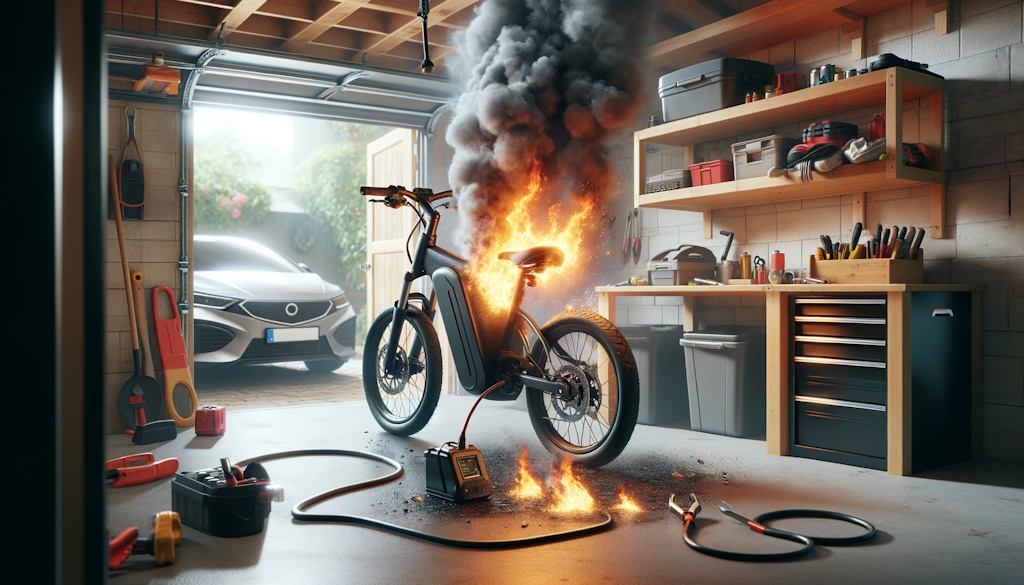
Safeguarding Against E-Bike Fires: A Guide for New York State’s Insured
E-Bike Fires: A Guide for New York’s Insured
In the rapidly evolving landscape of electric bicycles (E-Bikes), also known as Micro Mobility Devices (MMD) across New York State, safety standards have emerged as a pivotal concern, especially given the massive influx of these devices. In 2021 alone, almost 900,000 E-Bikes were imported into New York State, with a significant number originating from China. The challenge with many of these imports is the variability in safety standards, as manufacturing and testing protocols can differ significantly from those in the United States.
Recognizing and mitigating the risks linked to these devices is paramount for homeowners, renters, and college students. Lithium-ion batteries, the power source for most MMDs and E-Bikes, can pose a fire hazard if not correctly handled, charged, or stored. Most of the time, these vehicles are left charging while unattended, often in hallways or garage entrances, which can block vital escape routes in the event of a fire.
Fires are often caused by thermal runaway, a condition where a battery overheats and can lead to fires or explosions. This situation underscores the importance of adopting best practices for battery care, including using the correct charger, avoiding exposure to extreme temperatures, and monitoring the battery for signs of damage or wear, given the variance in the various sourcing locations and manufacturers of these batteries underscores the critical importance of seeking out E-Bikes that adhere to recognized safety certifications such as the UL 2849 rating.
Moreover, as these devices spread beyond urban centers, local fire departments and emergency services must be equipped and trained to deal with lithium-ion battery fires, which can be particularly challenging to extinguish.
First, How to Mitigate Safety Risks Caused by E-Bikes
- Proper Charging Practices: Always use the manufacturer-provided charger for your EV or e-bike. Charging devices with non-standard or damaged cables can cause overheating and fires.
- Regular Maintenance: Regular checks and maintenance of your EV or e-bike are essential. Look for signs of wear or damage to the battery and electrical components, and address any issues promptly.
- Safe Storage: When not in use, store your e-bike or EV in a cool, dry place away from flammable materials. Avoid leaving these devices to charge unattended, especially overnight.
- Don’t Block Escape Routes: People often charge their electric vehicles near exit doors in garages and hallways, which is a critical mistake. Avoid blocking emergency exits with your e-bike.
- Purchase from Reputable Dealers: Buy EVs and e-bikes from reputable dealers who adhere to the highest safety standards and only sell UL 2849-rated devices. This ensures your device is less likely to have manufacturing defects that could lead to safety risks.
- Proper Fire Extinguisher: The best option is to use a Class D fire extinguisher designed for combustible metal fires. If a Class D extinguisher is unavailable, a dry powder extinguisher (Class ABC) can be used as a second option.
- Stay Informed: Keep abreast of any recalls or safety notices issued for your vehicle or equipment. Manufacturers may discover issues post-sale that need addressing to ensure safety.
E-Bike Insurance Considerations for New York Residents
For homeowners and renters in New York wondering if your homeowner’s or renter’s policy covers an e-bike fire, you may want to know that most insurance policies in New York State generally cover fire damage, including that caused by E-bike battery fires, under the “basic named perils,” which include fire, among other hazards. This means damage to the dwelling, other structures on the property, personal property, and even additional living expenses incurred due to the home being uninhabitable post-fire should be covered by your standard homeowner’s policy. Personal liability coverage would also come into play if the fire affected a neighbor’s property.
However, it’s important to note that while homeowners’ or renters’ insurance policies might offer a high coverage limit, there could be sub-limits for specific items, potentially including e-bikes. These sub-limits may not fully cover the replacement cost of an E-Bike, especially given that they can be quite expensive and susceptible to theft due to their high value and batteries. To ensure comprehensive coverage for an E-Bike, consider additional coverage through a scheduled property endorsement or a standalone E-Bike policy.
For more detailed guidance and to ensure your specific situation is covered, it’s recommended to consult directly with your insurance agent or broker to clarify the extent of your coverage and advise on any additional policies or endorsements that might be necessary to fully protect against the financial impact of an E-Bike battery fire.
It’s essential to understand how owning an MMD or e-bike may impact your insurance coverage:
- Personal Property Insurance: Check if your homeowner’s or renter’s insurance policy covers the cost of replacing an e-bike or EV in the event of a fire, as some insurance carriers may consider policy endorsements or exclusions pertaining specifically to e-bikes.
- Consult Your Agent: It is highly recommended that you consult directly with your insurance agent to clarify your coverage.
- Liability Coverage: Ensure that your policy covers any damage a fire from your MMD or e-bike might cause to other properties.
- Disclosure: Inform your insurance provider about the ownership of these devices, as they may be relevant to your coverage and premium calculations.
Conclusion
Adopting MMDs and e-bikes can be a step towards sustainable living for residents of New York. However, being aware of and actively mitigating the risks associated with lithium-ion batteries is crucial for safety. Insurance agents and providers are valuable resources for understanding how to protect yourself best, your property, and your investments in these technologies. Always communicate openly with your insurer about the devices you own and follow the best practices for their use and maintenance to ensure a safe and secure experience. Always check with your agent to clarify any coverage questions.








